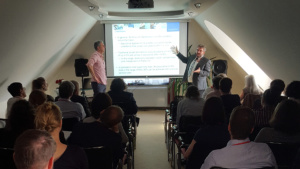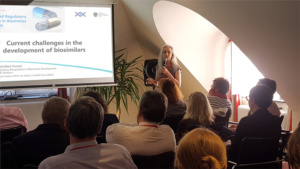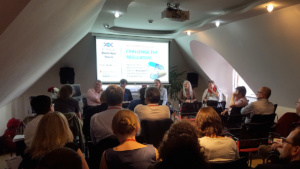Three years ago, in January 2016, when the idea of such a forum first popped up in a personal discussion (between the president of the Viennese Section of the International Biometric Society at that time and the president of the Hungarian Society for Clinical Biostatistics) noone thought that a long-standing tradition just started, and one could not predict how long this series of events will survive.
Excerpt from the first announcement in 2016: “This two-day event is targeted to clinical research professionals working in the area of biosimilars. Topics will include current issues and challenges confronting researchers in this important field. The objective is to provide participants with an environment to engage in open and constructive dialogue with like colleagues to facilitate collaboration”. The keyword in this text is the “environment”. Maybe it was indeed the sincere and friendly atmosphere which made this event so special (distinguishing it from the many other similar conferences) from the very beginning. New topics were brought up each year, and now, at the end of the fourth Biosimilars Forum the organizers can be optimistic about the future, the glass is already half full, that is some of the next year programs were already fixed.
This year the structure was similar to previous forums: a short course on the first day, followed by presentations and discussions on the second day.
 Robert Schall’s and Divan Burger’s lecture on robust methods for the assessment of average and scaled average bioequivalence presented an interesting new solution for addressing the violation of ANOVA assumptions. The classical topic of situations when the normality condition does not hold was studied by many authors but the known options are not very convincing, and some of them are even incorrect (like pre-testing the assumptions, and basing the choice between tests on the result of a test for normality). The authors of the short course proposed a new method in which t-distributed residual errors are assumed. The t-distribution proved to be flexible enough to handle skewed and heavy-tailed distributions (including outliers) in a unified framework.
Robert Schall’s and Divan Burger’s lecture on robust methods for the assessment of average and scaled average bioequivalence presented an interesting new solution for addressing the violation of ANOVA assumptions. The classical topic of situations when the normality condition does not hold was studied by many authors but the known options are not very convincing, and some of them are even incorrect (like pre-testing the assumptions, and basing the choice between tests on the result of a test for normality). The authors of the short course proposed a new method in which t-distributed residual errors are assumed. The t-distribution proved to be flexible enough to handle skewed and heavy-tailed distributions (including outliers) in a unified framework.
 Following the thought-provoking short course some other methodological issues were addressed next day. One of them was Balaam’s design which was not very popular in the past (perhaps due to its inefficiency in terms of sample size) but nowadays it is recommended for interchangeability studies. Júlia Singer presented a summary of apparently different models applied which often lead to the same result, pointing out that inefficiency continues to be a drawback of this design.
Following the thought-provoking short course some other methodological issues were addressed next day. One of them was Balaam’s design which was not very popular in the past (perhaps due to its inefficiency in terms of sample size) but nowadays it is recommended for interchangeability studies. Júlia Singer presented a summary of apparently different models applied which often lead to the same result, pointing out that inefficiency continues to be a drawback of this design.
 Switchability of biosimilars continues to be a controversial topic because the relevance and sensitivity of the proposed PK/PD approach was often questioned. László Tóthfalusi raised the possibility of characterizing switchability using long-term observational data. This type of analysis is closer to real life, and the need of switching occurs in a natural way (whereas in clinical studies switches occur after pre-defined periods). Time to need of switch (for which multiple reasons like decreasing efficiency, side effects etc. can be identified) is the primary endpoint in such observational studies. The results presented at the conference were convincing and informative. The hazard of treatment failure for a certain product is a clinically meaningful and sensitive parameter, enabling also the comparison of more biosimilars of a same originator, and also the analysis of risk factors (co-treatment, gender) from a relatively small clinical database. The variables necessary for this analysis can be obtained from health-insurance databases.
Switchability of biosimilars continues to be a controversial topic because the relevance and sensitivity of the proposed PK/PD approach was often questioned. László Tóthfalusi raised the possibility of characterizing switchability using long-term observational data. This type of analysis is closer to real life, and the need of switching occurs in a natural way (whereas in clinical studies switches occur after pre-defined periods). Time to need of switch (for which multiple reasons like decreasing efficiency, side effects etc. can be identified) is the primary endpoint in such observational studies. The results presented at the conference were convincing and informative. The hazard of treatment failure for a certain product is a clinically meaningful and sensitive parameter, enabling also the comparison of more biosimilars of a same originator, and also the analysis of risk factors (co-treatment, gender) from a relatively small clinical database. The variables necessary for this analysis can be obtained from health-insurance databases.
 During the sample size evaluation of clinical studies in biosimilar development programs (like phase 1 equivalence of PK parameters, and phase 3 therapeutic equivalence) sample sizes are often underestimated due to the assumption of completely identical distributions for the originator and the biosimilar product. Alternatively, some sponsors routinely assume a small difference between means (like a typical ratio of 1.05 for the geometric means of PK parameters). Arne Ring presented a review of these approaches and proposed a more structured way of handling small differences between distributions by introducing the concept of assurance (expected power). The method is taking into account the uncertainty in the assumptions of sample size assessment, and usually leads to feasible sample sizes.
During the sample size evaluation of clinical studies in biosimilar development programs (like phase 1 equivalence of PK parameters, and phase 3 therapeutic equivalence) sample sizes are often underestimated due to the assumption of completely identical distributions for the originator and the biosimilar product. Alternatively, some sponsors routinely assume a small difference between means (like a typical ratio of 1.05 for the geometric means of PK parameters). Arne Ring presented a review of these approaches and proposed a more structured way of handling small differences between distributions by introducing the concept of assurance (expected power). The method is taking into account the uncertainty in the assumptions of sample size assessment, and usually leads to feasible sample sizes.
 Maybe the most expected session was the one in which regulators talked about challenges in biosimilar development. The keynote presentation was held by Andrea Laslop, starting with an overall picture of biosimilars in Europe: 61 products registered (out of which 7 were already withdrawn), corresponding to 15 originators. One of the differences between the regulation in EU compared to other regions is the decreasing role of in vivo studies, shifting the emphasis more and more to the quality attributes, and towards a deeper understanding of the relationship between quality attributes and clinical outcome. All this can be summarized in the principle of 3Rs, meaning: Replace, Reduce, Refine.
Maybe the most expected session was the one in which regulators talked about challenges in biosimilar development. The keynote presentation was held by Andrea Laslop, starting with an overall picture of biosimilars in Europe: 61 products registered (out of which 7 were already withdrawn), corresponding to 15 originators. One of the differences between the regulation in EU compared to other regions is the decreasing role of in vivo studies, shifting the emphasis more and more to the quality attributes, and towards a deeper understanding of the relationship between quality attributes and clinical outcome. All this can be summarized in the principle of 3Rs, meaning: Replace, Reduce, Refine.
 Ina-Christine Rondak presented reflections on statistical aspects at quality level (CHMP. Draft Reflection paper on statistical methodology for the comparative assessment of quality attributes in drug development. 2017) After a short historical overview the comments received on the draft Reflection Paper were summarized. These comments were summarized and discussed extensively last year during a 5-day workshop (CHMP. Meeting Report: Workshop on the draft reflection paper on statistical methodology for the comparative assessment of quality attributes in drug development. 2018) where 31 representants of different pharma industry associtations, 31 EU regulators from 21 national competent authorities (+1 FDA representant) exchanged ideas. Some of the commenters pointed out that statistical decision should not be limited to a pass/fail criterion. Some of the other questions and concerns raised by commenters: the scope of reflection paper is too broad, more specific reflections dependent on the setting would be needed. The reflection paper uses the term similarity but it does not give an exact definition. There might be an inherent contradiction between „consistent manufacturing“ and shift/drifts in means.
Ina-Christine Rondak presented reflections on statistical aspects at quality level (CHMP. Draft Reflection paper on statistical methodology for the comparative assessment of quality attributes in drug development. 2017) After a short historical overview the comments received on the draft Reflection Paper were summarized. These comments were summarized and discussed extensively last year during a 5-day workshop (CHMP. Meeting Report: Workshop on the draft reflection paper on statistical methodology for the comparative assessment of quality attributes in drug development. 2018) where 31 representants of different pharma industry associtations, 31 EU regulators from 21 national competent authorities (+1 FDA representant) exchanged ideas. Some of the commenters pointed out that statistical decision should not be limited to a pass/fail criterion. Some of the other questions and concerns raised by commenters: the scope of reflection paper is too broad, more specific reflections dependent on the setting would be needed. The reflection paper uses the term similarity but it does not give an exact definition. There might be an inherent contradiction between „consistent manufacturing“ and shift/drifts in means.
 Andreas Brandt continued these thoughts by analysing the questions and concerns from statistical point of view, pointing out that similarity can’t be identified with equivalence in mean, but with equivalence in distribution. And the main distinction between descriptive and inferential statistics does not consist in different methodologies but in the conclusions drawn from the results (valid only for the observed batches or extrapolating for other batches as well).
Andreas Brandt continued these thoughts by analysing the questions and concerns from statistical point of view, pointing out that similarity can’t be identified with equivalence in mean, but with equivalence in distribution. And the main distinction between descriptive and inferential statistics does not consist in different methodologies but in the conclusions drawn from the results (valid only for the observed batches or extrapolating for other batches as well).
 Stephan Lehr’s interactive presentation (during which – like in a quiz – the audience had to guess and recognize some quotations from different guidelines) formulated some challenging questions preparing in a way also the next session. Stimulating thoughts were grouped around 4 topics:
Stephan Lehr’s interactive presentation (during which – like in a quiz – the audience had to guess and recognize some quotations from different guidelines) formulated some challenging questions preparing in a way also the next session. Stimulating thoughts were grouped around 4 topics:
- Revision of „products containing recombinant granulocyte-colony stimulating factor”
- Guideline on estimand in clinical equivalence trials (Appendix to ICH E9)
- Bayesian approaches to demonstrate biosimilarity
- Development in rare diseases
 This session was followed by a regulatory panel discussion and Q&A type of interaction in which replies were given to critical questions from the audience with a focus on the current regulatory requirements, approval process and burning issues of debate facing clinical development teams specialized on biosimilars.
This session was followed by a regulatory panel discussion and Q&A type of interaction in which replies were given to critical questions from the audience with a focus on the current regulatory requirements, approval process and burning issues of debate facing clinical development teams specialized on biosimilars.
It seemed that the main challenge for companies developing biosimilars was still the “moving target” phenomenon, i.e. the fact that the originator also has its own life cycle in which changes in the manufacturing process may occur. Some of the questions referred to the new terminology defined in the appendix of the old statistical guideline (ICH E9 (R1) addendum on estimands and sensitivity analysis in clinical trials to the guideline on statistical principles for clinical trials) which is expected to become effective in the near future, with some changes compared to the draft version (due to the large number of comments received to the draft version).
Discussions were open, colloquial, thought-provoking, and could be continued „till cows come home”, but had to be censored once. However, the participants were confident that they will meet next year at the 5th forum.
REFERENCES – LIST OF THE DOWNLOADABLE PRESENTATIONS
The presentation materials of the professionally very fruitful 4th Annual Biosimilars Forum are available to download as a courtesy of the event series.
100% free. Sign up in 30 seconds and we will email you an access to the essential lectures in biosimilar development within 1 business day: DOWNLOAD: All Presentations
 17 OCT, 2019 | 1st DAY: COURSE MATERIAL
17 OCT, 2019 | 1st DAY: COURSE MATERIAL
- Robust methods for assessment of average and scaled average bioequivalence
 Robert SCHALL
Robert SCHALL
Professor, Statistical Consultation Unit, Department of Mathematical Statistics and Actuarial Science, University of the Free State, South Africa
 Co-author:
Co-author:
Divan BURGER
Senior Lecturer, Department of Statistics, University of Pretoria, South Africa
 18 OCT, 2019 | 2nd DAY SYMPOSIUM: Clinical Research and Regulatory
18 OCT, 2019 | 2nd DAY SYMPOSIUM: Clinical Research and Regulatory
- Balaam’s Design Revisited
 Júlia SINGER
Júlia SINGER
Chief Scientific Officer, Accelsiors CRO Ltd.;
President of the Hungarian Society for Clinical Biostatistics, Hungary
 Co-author: Joëlle MONNET GAUD
Co-author: Joëlle MONNET GAUD
Director, Biostatistics,
Fresenius-Kabi SwissBioSim GmbH, Switzerland
- Measuring switchability using observational data
 László TÓTHFALUSI,
László TÓTHFALUSI,
Associate Professor,
Faculty of Pharmacology, Semmelweis Medical University, Hungary
 Co-author: László ENDRÉNYI
Co-author: László ENDRÉNYI
Professor Emeritus of Pharmacology and Biostatistics, University of Toronto; Former President of Canadian Society for Pharmaceutical Scientists, Canada
- Applications of the expected power (statistical assurance) for bioequivalence trials
 Arne RING
Arne RING
Professor of Statistics, University of the Free State, South Africa;
Head of Biometrics and Statistical Programming, medac GmbH, Germany
- Regulatory Keynote:
Current challenges in the development of biosimilars
 Andrea LASLOP
Andrea LASLOP
Head of Scientific Office, Austrian Medicines and Medical Devices Agency (AGES), Austria; Member of the Scientific Advice Working Party (SAWP) of the European Medicines Agency; Austrian delegate in the Committee for Human Medicinal Products (CHMP) of the European Medicines Agency
- Regulatory reflections on biosimilar development and statistical methods used at quality level
 Ina-Christine RONDAK
Ina-Christine RONDAK
Biostatistician, Seconded National Expert from Klinikum rechts der Isar of Technische Universität München to EMA, Germany
- Quality and statistics: bringing two worlds together
 Andreas BRANDT
Andreas BRANDT
Statistical assessor,
Federal Institute for Drugs and Medical Devices (BfArM), Germany
- Is similarity different? – Recent developments from the regulatory perspective
 Stephan LEHR
Stephan LEHR
Biostatistician, Austrian Medicines and Medical Devices Agency (AGES);
Assessor, EMA Biostatistics Working Party; Alternate Member, EMA Scientific Advice Working Party; Former President of the Viennese Section of the International Biometric Society, Austria











